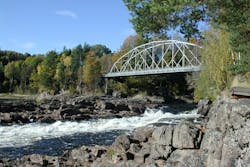U.S. EPA Gives Charles River B+ for Water Quality
The U.S. Environmental Protection Agency (EPA) gave a grade of "B+" for the Charles River water quality during 2015. The Charles River runs through Massachusetts. Water quality improved slightly from the 2014 calendar year, but fell just short of an "A-."
This is the 21st year EPA has issued a Charles River Report Card. EPA's grade of "B+" for the lower Charles River is based on bacterial sampling conducted by the Charles River Watershed Association (CRWA) over the 2015 calendar year. CRWA collects monthly water quality samples at ten monitoring sites from the Watertown Dam to Boston Harbor. In 2015, the Charles River met the state's bacterial water quality standards for boating 95% of the time and for swimming 69% of the time.
The grade is determined by comparing the amount of time the river meets water quality standards to the following criteria:
A – Almost always met standards for boating and swimming;
B – Met standards for almost all boating and some swimming;
C – Met standards for some boating and some swimming;
D – Met standards for some boating but no swimming; and
F – Did not meet standards for boating or swimming.
The grading is also based on a comparison to previous years' grades and whether the water quality has improved.
The lower Charles River has improved dramatically from the launch of EPA's Charles River Initiative in 1995, when the river received a “D” for meeting boating standards only 39% of the time and swimming standards just 19% of the time. These improvements were due to a significant reduction in the amount of Combined Sewer Overflow (CSO) discharges to the river over the past 20 years, as well as enforcement of water quality standards and removal of illicit discharges, like cracked and leaking sewer pipes or improper sewer connections to the storm drain system. In addition, earlier this year, EPA issued an updated Municipal Separate Storm Sewer System (MS4) permit for Massachusetts. The new MS4 permit will build upon this past work and update storm water management efforts across Massachusetts, better protecting rivers, streams, ponds, lakes and wetlands across the Commonwealth.
As collaborative efforts between EPA, state and local government, private organizations, and environmental advocates continue, the goal of a consistently healthy river becomes closer to an everyday reality. For the second year, EPA launched a water quality-monitoring buoy in front of the Museum of Science in the Charles River lower basin. This buoy measures water quality in near real time. The data is being streamed live on EPA's Charles River Website.
The Charles River report card announcement comes at a time when the Museum of Science Boston has opened its new permanent exhibition, the Yawkey Gallery on the Charles. The Yawkey Gallery explores the intersection of natural and engineered worlds through the lens of the Charles River. Located in the heart of the Museum—directly between Boston and Cambridge—the exhibit offers spectacular views of the river, hands-on activities, and live animals where visitors can learn about the interplay between an urban environment and the River. The Yawkey Gallery also features live water quality data from the EPA buoy, where visitors will be able to access the data both in the museum and at home. Since its inception, EPA’s Charles River initiative has been based on solid scientific understanding of the River based on data collected over the years. The river has also served as a laboratory for new methods of monitoring its health, reflected in innovations such as remote monitoring of water quality by methods such as the buoy.
Aside from illicit discharges, storm water containing phosphorus and the algae it produces are some of the major pollution problems remaining. These are problems that every citizen can help tackle. A major load of phosphorus comes from fertilizer and runoff from impervious surfaces like roads and rooftops. Citizens have been the driving force behind the Charles River Initiative and they can continue to help improve water quality in the River while monitoring progress themselves.
"EPA's grade tells all involved we've come a long way, but we've been plateaued at B+ for a while. With the end of the heated cooling water discharge from Veolia's Kendall Square electric generation this summer, and with our continued work with EPA on stormwater discharges to the Charles, I’m hopeful in the coming few years we’ll see the grade tick up meaningfully," said Bob Zimmerman, executive director of the Charles River Watershed Association.
"At the Museum of Science, we strive to empower our visitors to be informed science learners," said Christine Reich, vice president of exhibit development and conservation for the Museum of Science. "We are excited about our partnership with the EPA through the annual EPA Charles River grade announcement and the buoy in front of the Museum that provides the public with real-time data about the state of the Charles. Along with our new exhibition, the Yawkey Gallery on the Charles River, we hope these resources will inspire people to learn more about the world around them and better understand their relationship with the Charles River."
Source: U.S. Environmental Protection Agency


